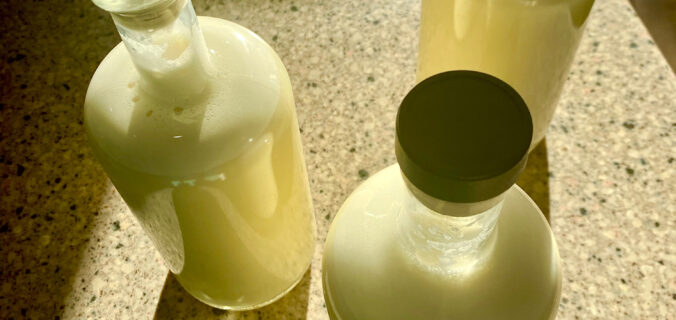First frost usually arrives in the Rogue Valley of Southern Oregon sometime around mid-October. This year it came just a bit early: Our backyard weather station registered 28 degrees on Tuesday morning.
Which means it’s time to make Eggnog.
It might seem too soon to be thinking about holiday beverages, including Eggnog. For decades I did what almost everyone else does: The week before Christmas, buy one of those bright yellow cardboard cartons from the grocery store; spike a glass of the pale yellow liquid with a shot of bourbon or brandy; drink a toast to the tannenbaum or the totem of your choice.
But, no surprise, the superior Nog is the homemade kind. Not only that, it’s better (and safer) when it’s aged—a minimum, I think, of six weeks, and preferably 10. Which means, if I want to sneak a sip for myself around Thanksgiving, and then generously pass around some full frothy mugs by late December, I need to get to fixing right now.
Nog-like drinks have been around a lot longer than most other cocktails we consume today, yet their origins are more clear. Posset, a warm milk and ale punch, was used as a medicinal as early as the 13th century; as time went on, eggs, breadcrumbs, and spices were often added. In his plays, Shakespeare made several mentions of posset (Lady Macbeth served posset à la poison to knock out Duncan’s bodyguards); recipes of that era call for cream, eggs, sugar, booze, and nutmeg.
Which is often called Eggnog.
The Nog’s more recent association with the holiday season is a bit more obscure. The best explanation is simply that a boozy, rich drink is not something typically craved at the height of summer, particularly if there’s heavy labor to be performed in the fields and factories. Rather, a cup of Nog, especially if served hot, was an indulgence to be savored on a cold night sometime around the winter solstice.
Which is often called Christmas.
Our own holiday ritual recipe came via my friend and voiceover artist extraordinaire Beth Winsor Stewart, who turned me on to celebrity chef Alton Brown’s take on Eggnog. Its mixture of three different alcohols, three different dairies, and a dozen egg yolks, aged for at least a couple of months, yields a velvety decadence that easily beats anything from a carton.
And about those eggs: Yeah, they’re raw. Consuming uncooked eggs, as the FDA reminds us, carries a risk of salmonella poisoning. The risk, however, is small, and reduced further by the addition in Brown’s recipe of all that booze—about 30 percent of the total volume. As researchers at the Laboratory of Bacterial Pathogenesis and Immunology at Rockefeller University have concluded, aging Eggnog for at least six weeks allows the alcohol to kill any nasties that might lurking in the yolks. In fact, the lab staff has been serving it that way for more than half a century.
But if you are immunocompromised or simply want to play it safe, feel free to substitute pasteurized eggs in the recipe.
And then get creative. Mixologists have spent the better part of seven centuries perfecting variations of the basic egg-dairy-liquor formula, so feel free to innovate. Leo Robitschek, author of The NoMad Cocktail Book, suggests adding Frangelico for a hint of hazelnut. The Cocktail Codex version calls for vanilla liqueur. Most intriguing is a warm version, from Mittie Hellmich’s Ultimate Bar Book, that uses cinnamon-spiced Mexican chocolate for a grand symbiosis of Eggnog and hot cocoa.
Which is often called delicious.
Aged Eggnog
Adapted from Alton Brown
12 large eggs
1 pound sugar
1 teaspoon freshly grated nutmeg
1 pint half-and-half
1 pint whole milk
1 pint heavy cream
1 cup rum
1 cup cognac
1 cup bourbon
1/4 teaspoon kosher salt
Separate egg yolks from whites; store the latter for other uses.
In a large mixing bowl, combine yolks, sugar, and nutmeg, and beat with a hand mixer until the mixture lightens in color and falls off the whisk in a solid ribbon.
Combine dairy, liquors, and salt in a second bowl. Slowly beat into the egg mixture until everything is uniform.
Pour mixture into glass jars or bottles with good lids. Store in refrigerator for a minimum of six weeks.
Serve topped with a little nutmeg grated on top.
Mexicocoa Eggnog
Adapted from Ultimate Bar Book by Mittie Hellmich
4 cups Eggnog
1 teaspoon ground nutmeg
1/2 teaspoon ground cloves
2 tablespoons unsweetened cocoa powder
1/2 cup grated Mexican chocolate, plus shavings for garnish
Whisk together the Eggnog, spices, and cocoa powder in a large saucepan. Heat over low to medium-low heat until barely simmering (do not boil). Slowly add grated Mexican chocolate, whisking to melt. Remove from heat and pour into warmed mugs. Garnish with a sprinkling of Mexican chocolate shavings. Serves 4.

